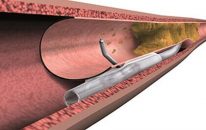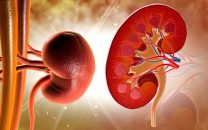The potential need for a 7-Fr guidewire, the use of several coronary guidewires and/or a kissing balloon, and the requirement of indispensable monitoring by intravascular ultrasound (IVUS) have been used by some interventional cardiologists as excuses to resist radial access. In that sense, left main coronary artery angioplasty was the last stand of femoral access.…
Clinical Improvement Without Ventricular Function Improvement After CTO
The benefits offered to patients by attempting the rechanneling of a chronic total occlusion are still unclear. Additionally, sometimes the procedural risks are somewhat undetermined. Taking into account these controversies, this work sought to prove whether successful rechanneling of a chronic total occlusion improves ventricular function. This is not a soft endpoint; it has been…
EXCEL Sub-Analysis: Angioplasty vs. Surgery in Chronic Renal Insufficiency
EXCEL patients with chronic kidney disease and left main coronary artery disease have higher rates of acute renal failure and other events compared with the general population. However, acute renal failure was less frequent with angioplasty than with surgery, while other events such as death, stroke, or infarction at 3 years were similar for both revascularization…
TCT 2018 | MAIN COMPARE: Angioplasty vs. Surgery for Left Main Coronary Artery Disease at 10 Years
Several studies (some of them recent, some of them not so much so) have compared left main coronary artery angioplasty and myocardial revascularization surgery. Combined, these works compose a large corpus of evidence, but follow-up has not gone beyond 5 years in any case. The main aim of this study (presented at TCT 2018 and published simultaneously…
An Effort Worth Your While: Rechanneling vs. Optimal Medical Treatment in Total Occlusions
Successful rechanneling of a chronic total occlusion (currently around 90%) leads to significant improvement in quality of life and symptom frequency in patients with stable chronic angina compared with optimal medical treatment alone. These results are promising and what we ultimately expected, although symptoms, as a primary endpoint in themselves, are in the eye of…
Antiaggregation Time after Treating Bifurcations
Defining dual antiplatelet therapy (DAPT) seems a never-ending story. We go from trials showing the safety of shorter schemes thanks to new generation stents to others suggesting up to two years of DAPT. Rather than finding a general scheme, it seems to be about adjusting DAPT on a case by case basis, according to ischemia…
SOLACI-SOCIME 2018 | Justification of PCI for Coronary Chronic Total Occlusion
Read articles on the main presentations of the first day of SOLACI-SOCIME 2018 Congress. See the presentation by Dr. Jaikirshan Khatri, entitled “Justification of PCI for Coronary Chronic Total Occlusion”. We are interested in your opinion. Please, leave your comments, thoughts, questions, etc., below. They will be most welcome.
Left Main PCI: Despite Auspicious Long-Term Outcomes, Optimal Strategy Still under Discussion
Left main coronary artery bifurcation interventions have shown very good results at long term, especially with new generation DES. The one-stent strategy has seen better results than the two-stent strategy, according to this registry recently published in J Am Coll Cardiol Intv. However, how does this registry of the daily practice between the years 2002 and…
EXCEL Sub-Study: The Site of the Left Main Coronary Artery Lesion Does Not Alter History
The EXCEL study, originally presented at TCT 2016 and published simultaneously in the New England Journal of Medicine (NEJM), showed that angioplasty and surgery in patients with left main coronary artery disease have similar rates of mortality, infarction, and stroke at 3 years. This sub-study, recently published in J Am Coll Cardiol Intv, adds that the…
Should Sex Be Taken into Account with Left Main Coronary Artery Revascularization?
The EXCEL trial did not find the sex of patients with left main coronary artery disease to be an independent predictor of adverse events after revascularization. However, women who underwent angioplasty had a trend towards worse outcomes, a finding that might be related to comorbidities and somewhat increased chances of peri-procedural complications. In its formal…
CTO Revascularization Improves Quality of Life
Courtesy of Dr. Carlos Fava. The presence of CTO hovers around 15, 20% in coronary angiographies of patients with chronic stable angina, but only 5% receive percutaneous coronary intervention (PCI). One of the obstacles to percutaneous revascularization is the lack of relevant studies justifying it, though we do have different comparative studies that improve symptoms, ventricular…










